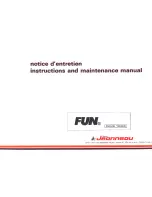
LACE MAIN TRAMPOLINE - Tie a bowline knot to the forward
left/port grommet in the
trampoline.
Pass the line through the
opposite grommet, top/down
and then through the lacing
flap.
Come up through the next
(left) grommet and then
continue to lace towards
the aft of the trampoline
following this pattern
(down through the right
grommets and up through
the left grommets). Keep
the laces loose at this time. Lace as far aft as the line will go.
Locate the aft lace rod. Feed
the rod through the rear pocket
as shown. Center the rod, from
left to right, in the pocket.
Locate the aft lace lines. Tie
to the rear grommets using a
long looped bowline as shown
(left and right sides).
Let the tramp hang below the aft
crossbar. Pull the lace lines under
the cross bar and tight. Begin the
aft lacing by routing the left line up
and over the first lace peg.
Cross over to the next peg
then down and around the
rod. Pull the lace line tight
then up and over the peg
and then over to the next
one and so on... Then
start with the right side
and work towards the
center.
Image to left shows the proper
routing of the lace lines around
rod and peg.
When you reach the center,
the pattern must be changed
slightly. Pass up and over the
last peg, before the center, and then down around the rod in
the gap between tramp halfs. Then, come up and through the
trampoline grommet on the
opposite side. Once tied off
loosely at the center, cinch the
line tight from each side working
towards the center.
Tie off to the main
trampoline grommets just
forward of the aft cross
bar.
Once the aft lace is tight, begin
cinching the center lace tight
from forward to aft. You will
notice that as you get the
trampoline tight you will have
more lace line aft to complete the
lacing.
Work your way aft until the entire trampoline is
tight. Tie off the line with a few half hitches.
Tuck the lace flap into the
opposite side lace line. The
flap will help keep you drier
while sailing and keep lines
from slipping into the water
between the laces.
7
Содержание Gateway
Страница 1: ...ASSEMBLY MANUAL ...






































